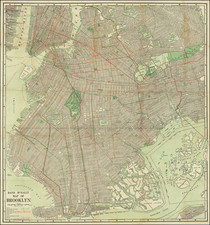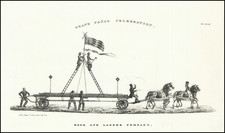Monumental Plan of New York City During the American Revolution
Rare J. H. Colton lithographic version of the exceptional Bernard Ratzer map of New York.
An unparalleled map for its detail and grandeur, Bernard Ratzer's map of the New York City area is without question the most decorative and sought after 18th Century plan of New York City among collectors and an historic artifact of the highest order. This 1853 edition by J.H. Colton, himself perhaps the most important American mapmaker of the 19th century, is the best reasonably-obtainable edition of the map.
Bernard Ratzer's map was by far the most accurate published plan of New York City and its environs at this critical time in history. The map is based on the surveys undertaken at the direction of Sir Henry Moore, who authorized mapping efforts in response to the Stamp Act Riots of 1765. He and other British leaders feared that the city might soon become a battleground -- a fear they no doubt carried over from the barely-concluded French and Indian War. Needing a more detailed accounting of New York's layout, the British authorities commissioned Ratzer to survey and construct a map the city, which was drawn in 1766.
Ratzer's map was completed to a level of detail unparalleled in a study of an American city; the work is fitting of an official map of a major English city.
Manhattan above Duane Street (unnamed here) is almost entirely given over to country estates and common land, with the exception of a still-developing area around the Bowery, west of Delancy Square. The country estates are labeled with the names of approximately 20 landowners, which will be familiar to students of New York history (Stuyvesant, Bayard, Delancy, Beekman, Harrison, Murray, Watts, Duane, Tiebout, etc.). The Bowery (here "Bowry") leads up through the center of the island before splitting into Bloomingdale Road and the "Road to King's bridge or Boston".
A successful effort has been made to render pictorially elevation, fields, marshes, salt meadows, and gardens around the city. The general effect is comprehensive enough to transport one back in time.
This edition leaves out the view that is at the bottom of the original Ratzer 1776 Ratzer.
The 1853 map was lithographed & printed by Schedler & Liebler 129 William St. N.Y. It includes a certification from William Perris: "City Hall Place, New York 18th May 1853. I hereby Certify, that I have compared this map with the Original in the Possession of J. Carson Brevoort, Esqre. and found it uniformly correct."
Rarity
The Colton and the original Ratzer are both very rare on the market. This is the second example we have had in over 30 years.
G. W. & C. B. Colton was a prominent family firm of mapmakers who were leaders in the American map trade in the nineteenth century. Its founder, Joseph Hutchins Colton (1800-1893), was a Massachusetts native. Colton did not start in the map trade; rather, he worked in a general store from 1816 to 1829 and then as a night clerk at the United States Post Office in Hartford, Connecticut. By 1830, he was in New York City, where he set up his publishing business a year later.
The first printed item with his imprint is dated 1833, a reprint of S. Stiles & Company’s edition of David Burr’s map of the state of New York. He also printed John Disturnell’s map of New York City in 1833. Colton’s next cartographic venture was in 1835, when he acquired the rights to John Farmer’s seminal maps of Michigan and Wisconsin. Another early and important Colton work is his Topographical Map of the City and County of New York and the Adjacent Country (1836). In 1839, Colton began issuing the Western Tourist and Emigrant’s Guide, which was originally issued by J. Calvin Smith.
During this first decade, Colton did not have a resident map engraver; he relied upon copyrights purchased from other map makers, most often S. Stiles & Company, and later Stiles, Sherman & Smith. Smith was a charter member of the American Geographical and Statistical Society, as was John Disturnell. This connection would bear fruit for Colton during the early period in his career, helping him to acquire the rights to several important maps. By 1850, the Colton firm was one of the primary publishers of guidebooks and immigrant and railroad maps, known for the high-quality steel plate engravings with decorative borders and hand watercolors.
In 1846, Colton published Colton’s Map of the United States of America, British Possessions . . . his first venture into the wall map business. This work would be issued until 1884 and was the first of several successful wall maps issued by the firm, including collaborative works with D.G. Johnson. From the 1840s to 1855, the firm focused on the production of railroad maps. Later, it published a number of Civil War maps.
In 1855, Colton finally issued his first atlas, Colton’s Atlas of the World, issued in two volumes in 1855 and 1856. In 1857 the work was reduced to a single volume under the title of Colton’s General Atlas, which was published in largely the same format until 1888. It is in this work that George Woolworth (G. W.) Colton’s name appears for the first time.
Born in 1827 and lacking formal training as a mapmaker, G. W. joined his father’s business and would later help it to thrive. His brother Charles B. (C. B.) Colton would also join the firm. Beginning in 1859, the General Atlas gives credit to Johnson & Browning, a credit which disappears after 1860, when Johnson & Browning launched their own atlas venture, Johnson’s New Illustrated (Steel Plate) Family Atlas, which bears Colton’s name as the publisher in the 1860 and 1861 editions.
J.H. Colton also published a number of smaller atlases and school geographies, including his Atlas of America (1854-56), his Illustrated Cabinet Atlas (1859), Colton’s Condensed Cabinet Atlas of Descriptive Geography (1864) and Colton’s Quarto Atlas of the World (1865). From 1850 to the early 1890s, the firm also published several school atlases and pocket maps. The firm continued until the late 1890s, when it merged with a competitor and then ceased to trade under the name Colton.












![Map of the State of New York with Part of Upper Canada [Large inset plan of New York]](https://storage.googleapis.com/raremaps/img/small/91848.jpg)
![[Brooklyn] Manhattan Beach Estates - Map of Property situated in the Borough of Brooklyn](https://storage.googleapis.com/raremaps/img/small/80730.jpg)
![[Brooklyn] The Anderson T. Herd Realty Co's Map of the Borough of Brooklyn & Part of Queens with Present & Projected Transit Lines, Elevated & Surface Railways, Bridges, Tunnels & Subways . . . 1906](https://storage.googleapis.com/raremaps/img/small/84230.jpg)
![[Nolita -- Lower Manhattan] Map of Bayard's East Farm, Accurately Made From Old Maps, [not in Register's Office,] From Conveyances on Record from Nicholas Bayard, Sheriffs Sales, Lottery Lots &c. &c.](https://storage.googleapis.com/raremaps/img/small/61032.jpg)
